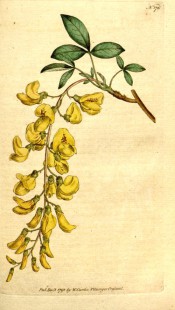Laburnum anagyroides Medik.
Fully-hardy spreading small tree with hairy grey-green young shoots, leaves consisting of 3 elliptic-obovate leaflets, and dense. pendant racemes of bright yellow flowers in spring and early summer. To 8m. [RHSE, Hortus, Hilliers’].
Horticultural & Botanical History
‘Of the Laburnum, our nurseries afford two principal varieties, the broad and narrow-leaved; the latter (which is the one here figured) Mr. Miller was induced to make a species of under the name of alpinum; it certainly differs very materially from the broad-leav’d one, yet is most probably only a seminal variety, the Laburnum figured in its wild state by Professor Jacquin, in his Flora Austriaca, has much broader leaves than ours, no mention is made by him of its being subject to vary. Both Miller and Hanbury recommend the Laburnum to be cultivated not only as an ornamental but as a timber tree, the wood having a very close grain, a good colour, and bearing a high polish; they urge in its favour, that it is very hardy, a quick grower, and one that will thrive in almost any soil; the latter says, it will become a timber tree of more than a yard in girt: whatever success may attend its cultivation for the more useful purposes, as a hardy, deciduous, ornamental tree, it has long been the pride of our shrubberies and plantations.
It blossoms in May, and is usually very productive of seeds, by which it may be propagated most readily.
Hares and rabbits being fond of its bark, do great damage to plantations of Laburnum, especially in severe weather; I remember somewhere to have read, that these animals will not touch a tree if soot has been placed about it; perhaps, a circle drawn round the base of the tree with the new coal tar, which has a powerful smell of long duration, might keep off these noxious animals.’ [BM t.176/1791]. Introduced to England in 1596. [PD].
History at Camden Park
Listed in all published catalogues [T.362/1843].
Notes
Published Dec 15, 2009 - 05:05 PM | Last updated Jul 21, 2010 - 12:24 PM
| Family | Fabaceae |
|---|---|
| Category | |
| Region of origin | Southern Europe |
| Synonyms |
|
| Common Name | Common laburnum, Golden chain |
| Name in the Camden Park Record |
Cytisus laburnum - Laburnum |
| Confidence level | high |


